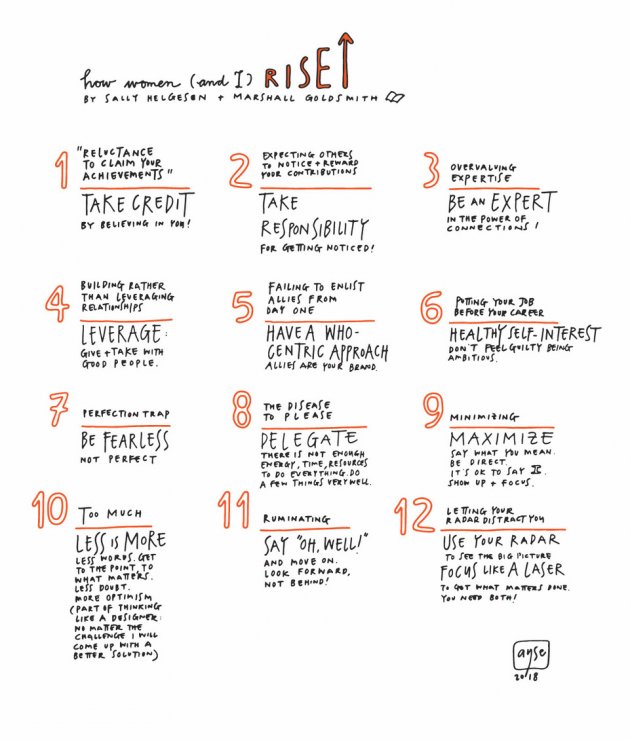I have always found new year resolutions difficult (with the exception of Woody Guthrie's beautiful 1942 version). I prefer writing manifestos when it comes to the future.
I wrote about the Manifesto Exercise around this time last year. Denny Post, CEO of Red Robin, shared it on Facebook at the end of this year, recommending it to her friends as a different way of doing their new year resolutions. That inspired me to do mine, below, and update it with some new categories.
"Ayse Birsel authored this piece last year in INC - it's a practical, efficient and inclusive approach to setting yourself up for the New Year!" Denny Post
The Manifesto Exercise will help you think like a designer about your work for 2019.
I recommend that you do one alone and then do it again with your team. Remember you'll be thinking like a designer--with optimism, looking at the big picture, and with empathy for yourself (and each other, if you're doing it with your team).
Ground rules are the same as last year: Give yourself 25 minutes total. If you run out of time, take a short break before you complete it. Speed is part of the game in that it helps you go with your gut and leaves less room for unnecessary self-judgment. Remember to do it playfully, because when we're playful we're like kids, fearless and open to learning by doing.
Time: 25 minutes, sometime in early January 2019.
A. DECONSTRUCT:
Map out your work life in 2018 across the following 6 categories (see my diagram and use it as a cheat-sheet).
Note: This year I found it useful to make loose notes for my deconstruction, adding items as things popped into my head, before sitting down to do it all in one go.
1. Emotion: Start with how you feel in this moment. Then think back to how you felt in 2018 and how you want to feel in 2019. List your feelings as they come to mind in one column.
Note: Emotions at work often run in opposite pairs--love/hate, success/failure, having a sense of purpose/feeling lost."
2. Information: Think about what you know about your work going into 2019. This can be your salary, the size of your team, the number of projects you're working on. List tangible information or data in this column.
3. Constraints: What holds you back you back or limits you? Your own constraints, like procrastinating and leaving things to the last minute, and constraints that you cannot control, like budgets.
4. Joy: What brings you joy at work? Thinking about what makes you happy will help you think about what matters to you at work and will help you to be more intentional about increasing your instances of joy.
Note: Last year Opportunity was #4. I intentionally moved it to #6, wanting you to circle through joy and gratitude (#5) first, to inspire your opportunities.
5. Gratitude: What were you grateful for in 2018? While joy is more personal, gratitude is often in relation to others. It's about getting the relation between ourselves and others right, one of the three foundations of happiness according to Jonathan Haidt, social psychologist and Professor of Ethical Leadership at New York University's Stern School of Business.
6. Opportunity: What are your opportunities as you start in 2019? These are things that align with your values, purpose and personal growth. They're positive, exciting, empowering.
Tip: Try turning your constraints into opportunities (for example, as one of our clients put it, many voices and opinions can be a constraint but it is also an opportunity.)
Note: Last year #5 was Out-of-the-box Opportunity (OOBO) for big dreams and leaps, "revolutions" versus "evolutions". This year they're inside the Opportunity column (See my OOBO in my diagram, daring me to think big.)
B. REFLECT:
Reflect on your deconstruction, above. Deconstruction helps you break a complex idea into its parts to make it more manageable. It visualizes your life at the cross-section of 2018 and 2019 so that you can decide what to keep, what to discard and what to change.
Now do your own dot-voting, picking one thing that rises to the top in each column. Go with your gut. You can put a star next to it (I underlined mine in red.) These are your 6 key ingredients for 2019.
C. WRITE YOUR MANIFESTO:
Your Manifesto is your declaration for 2019 based on the top 6 ingredients you chose above. Write it by combining them together in a paragraph:
Your Manifesto = Emotion + Information + Constraint + Joy + Gratitude + Opportunity.
Once you have your manifesto, gather your team--this can be over breakfast or lunch--to do the exercise together and to share your manifestos. Based on each other's manifesto, talk about what you need help with, what you can do together, and who can be your mentors, mentees or an accountability partners to collaborate with to bring your vision to life in 2019.
We use this tool to shift with our clients' mindsets from problems to opportunities, from feeling stuck to action, with great success. The process is almost mathematical in its simple formula yet vision-creating in its results. It's a key component of Design Quotient (DQ), our practice to teach leaders how to think like a designer and imagine tomorrow based on what you know today.
Wishing you a happy and creative 2019.
This article first appeared on Inc.com on January 3, 2018



